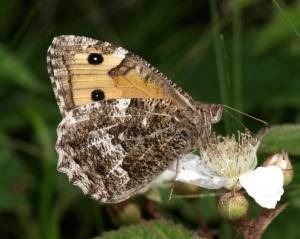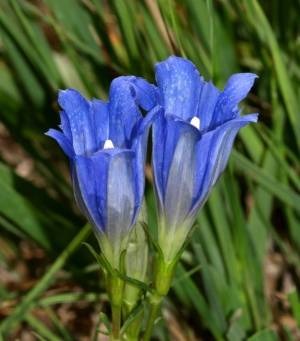Dr Phil Smith’s Wildlife Notes
August 2010
It is always pleasing to be able to report on wildlife surveys involving volunteers. This year, Merseyside BioBank obtained funding from the SITA Trust to organise a study of one of Sefton’s special insects: the Grayling butterfly. This species is considered to be under threat due to habitat loss, so it is covered by Biodiversity Action Plans, both nationally and in North Merseyside. About 40 volunteers were recruited, trained and allocated sections of the Sefton sand-dunes, the aim being to record the positions of all Graylings seen using a hand-held GPS device. This will enable the butterfly’s habitat to be more accurately defined so that conservation measures can be targeted. At the same time, the volunteers were asked to record other notable insects, including the Northern Dune Tiger Beetle and the Dark Green Fritillary.

Patricia Lockwood and I took on an area at Ravenmeols dunes and made several visits, recording up to 25 Graylings on our patch, though finding periods of suitable sunny weather during this generally unsettled month was tricky. Later, we extended our coverage to two other nearby areas, leading by chance to the discovery of a site for a tiny relative of the grasshoppers: the Common Groundhopper (Tetrix undulata). “Common” is a misnomer as far as the Sefton Coast is concerned, as I have seen this creature on only about three previous occasions in over 40 years and have never photographed it before. Only about 8mm long, the Groundhopper is incredibly well camouflaged and can hop a prodigious distance, thereby usually disappearing as quickly as you find one.
We saw lots of tiger beetles during our Grayling survey, these being confined to areas of bare sand where the butterfly also likes to bask. On one occasion, four of these charismatic beetles were running around between our feet, providing great entertainment!
A rare trip away from the Sefton Coast on 16th August saw a group of us visit Highfield Moss, Golborne, to record the spectacular Marsh Gentian (Gentiana pneumonanthe) at its only South Lancashire locality. We counted 169 flower-spikes, the largest number seen since the early 1980s. We also saw Common Hawker and Black Darter dragonflies, which are specialities of this wonderful peatland, as well as the Meadow Grasshopper, this being widespread in southern England but increasingly confined to peat bogs as you travel north. Another treat was the sight of two Hobby falcons hunting over the moss. Several other Hobby sightings were reported locally during August, reflecting a welcome increase in the region.

In August 2008, two species of Sea Lavender were found for the first time at Marshside, so Pat and I decided to repeat the survey. Tramping across the saltmarsh on 10th revealed a six-fold increase in the numbers of Common and Lax-flowered Sea Lavenders in only two years, with 60 plants of the former and 12 of the latter being counted. We also found two specimens of an apparent hybrid between the two species, this being rarely reported nationally. Sea Lavenders are quite long-lived and, as we had GPS co-ordinates for the individuals recorded in 2008, we were able to refind all but two of those plants. They have grown considerably, producing lots of the bright purple flower-heads that enabled us to spot them with binoculars from up to 50 yards away.
